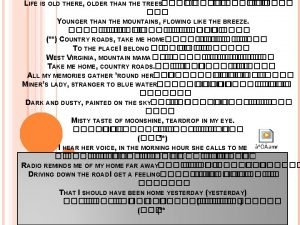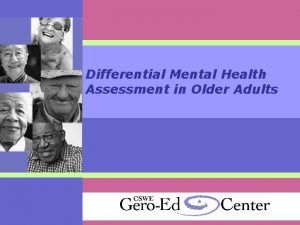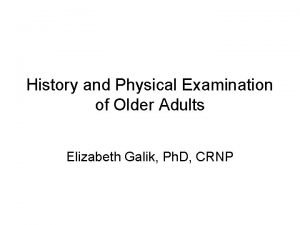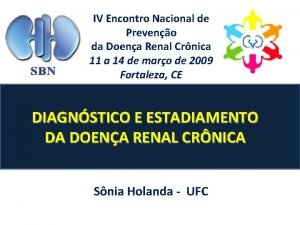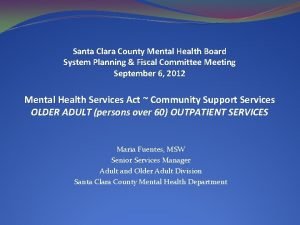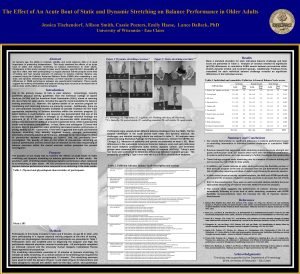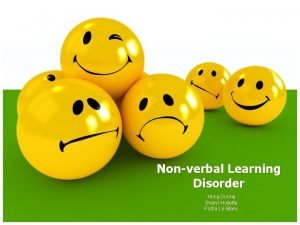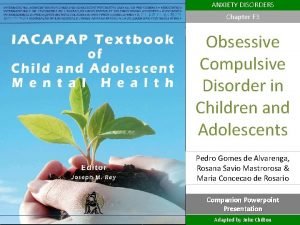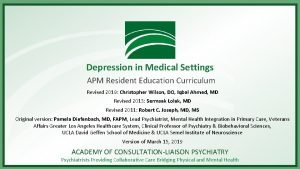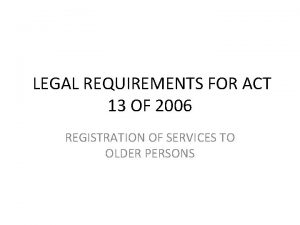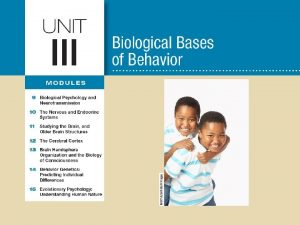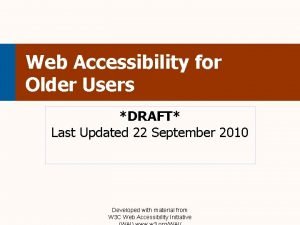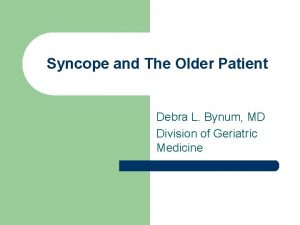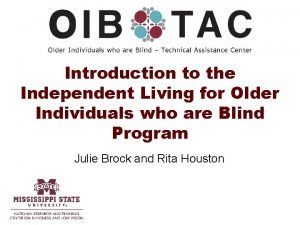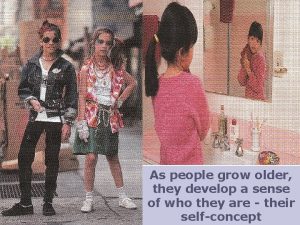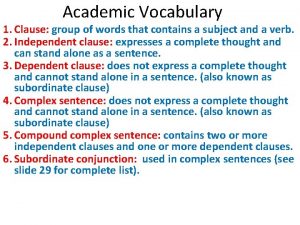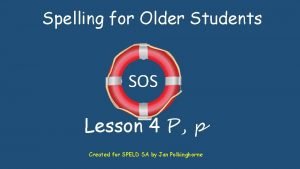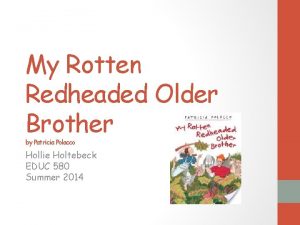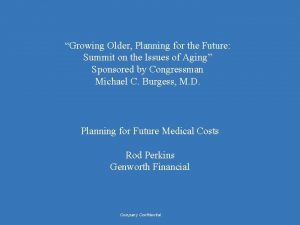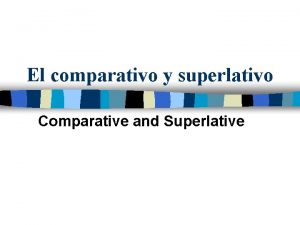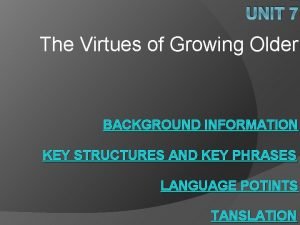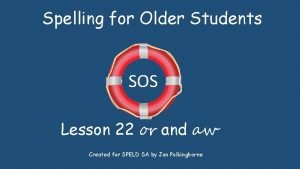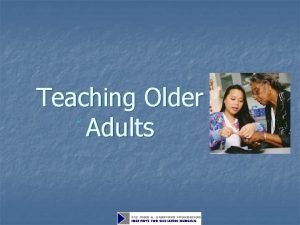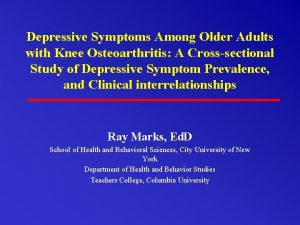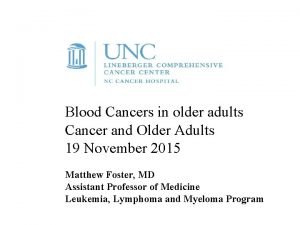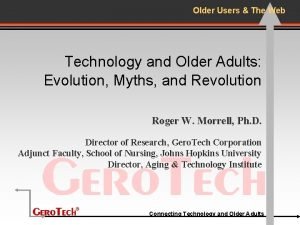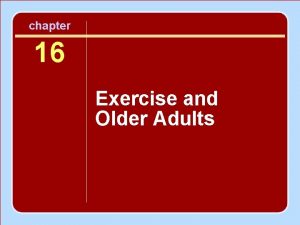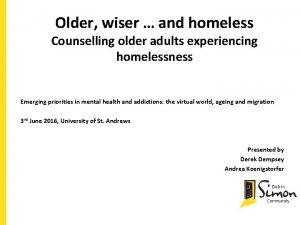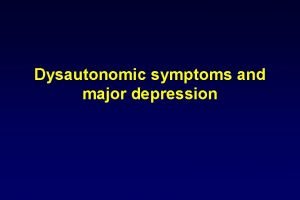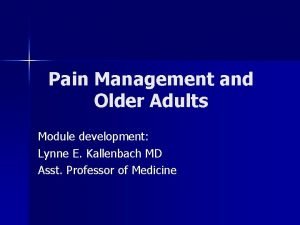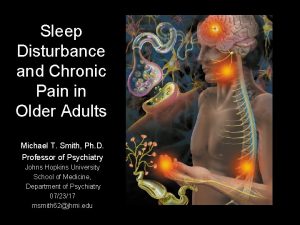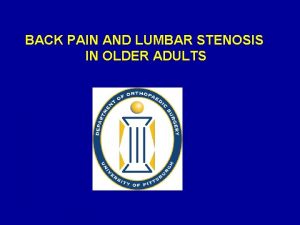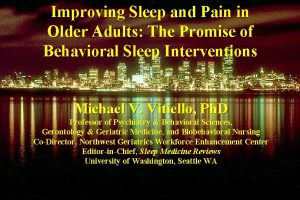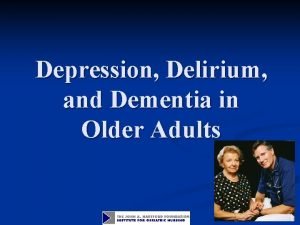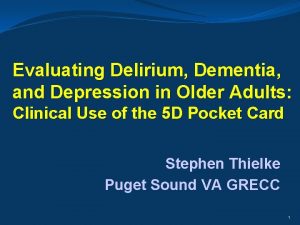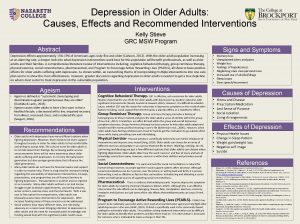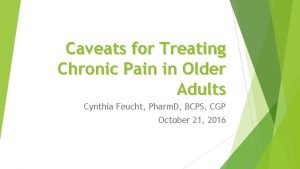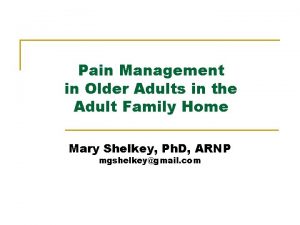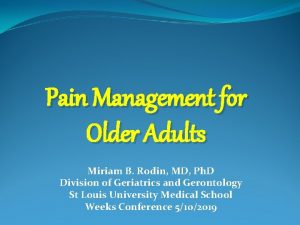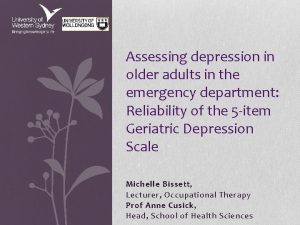Pain and symptoms of depression in older adults









































- Slides: 41

Pain and symptoms of depression in older adults living in community and in nursing homes: the role of activity restriction as a potential mediator and moderator 赵梦 2015. 3. 20 1 MEDICAL

Author & Magazine • Almudena López-Lopez Spain • International Psychogeriatrics 2 MEDICAL

Index Introduction Method Results Discussion and conclusions 3 MEDICAL

1 Introduction 4 MEDICAL

Introduction l l l Chronic pain is a common condition in older people, affecting more than 50% of elderly adults living in community settings and over 80% of NH residents Pain interferes in the everyday functioning of elderly people, both in NH care contexts and community settings , and has been related to depressive symptomatology in several pain conditions Depression is a significant problem in older people, in both community-dwellers and long-term care home residents 5 MEDICAL

Introduction In community settings, a recent longitudinal study found that pain interference in activity at baseline was a risk factor for developing depressive symptomatology at follow-up p pain strongly predicts future disability, which in turn predicts future-depressed mood, but the results from other longitudinal studies do not support the hypothesis • Other studies, though supporting the influence of both pain and functional interference in depressive symptomatology, do not test any moderation or mediation hypotheses. l 6 MEDICAL

Introduction l p l In institutionalized samples, there are scarce data analyzing the influence of activity restriction on the relationship between pain and symptoms of depression. Those classified as people with major depressive symptoms, reported more pain intensity, and people with greater pain intensity had more symptoms of depression. Other works found direct associations between pain intensity, depressive symptomatology, and activity restriction in NH, but they did not test any mediation or moderation hypotheses 7 MEDICAL

Introduction l l In sum, while several studies seem to support a mediator role of activity restriction in the relationship between pain and depression in older people with chronic pain, others do not support this role. (the different instruments) A remaining question is whether this role might vary acr -oss contexts (e. g. community and NH). p In community settings ---support a mediation role p In NH ---no studies have specifically analyzed this role. 8 MEDICAL

Introduction l p Objective Test the potential role of activity restriction as a moderator and mediator in the pain-depression relationship, in both community and nursing homedwelling older adults with pain. 9 MEDICAL

2 Method 10 MEDICAL

Method l Participants and procedure A cross-sectional study 231 20 declined 211 2: hospitalization 1: death 208 102:NH 108: community 1 11 MEDICAL

Method l p p p Participants and procedure Inclusion criteria: to be 65 years old or more; to have no oncological or organic-brain illness; good visual and hearing ability were required; to have no serious illness involving functional impairment; to have no serious chronic illness other than musculoskeletal problems, with the exception of hypertension or type 2 diabetes; MMSE ≥ 24 12 MEDICAL

Method l Depression p Geriatric Depression Scale (GDS) p A cut-point of 14 p 80% sensitivity rate 100% specificity rate 13 MEDICAL

Method l Pain Intensity p a composite measure involving four dimensions (current, worst, least, and average pain) p We used an 11 -point box scale (0 to 10) with color gradation(different shades of red) to measure each item. p Box scales, given that they combine numerical scales and visual analogue scales, are highly appropriate for measuring pain in the elderly 14 MEDICAL

Method Activity Restriction l p p Activity Restriction Scale This scale evaluates pain interference in several daily activities or areas of functioning: individual household activities, leisure, family relationships, social activity, sexual activity, self-care, and basic movement Each area of activity was assessed using a box scale with 11 points, from 0 to 10, where the participant had to indicate the degree to which pain interfered with the activity. 15 MEDICAL

Method l p p p Statistical analyses 1 Preliminary analyses univariate outliers : standardized scores above 3. 29 Multivariate outliers: Mahalanobis distance was greater than 16. 3 Student t-test analyses, Chi-square: In order to test whethere were differences between the community and NH samples in sociodemographic variables and in depression, pain intensity and activity restriction 16 MEDICAL

Method Statistical analyses l Direct associations p Pearson correlations (X Y M in C, NH) p Student t-test (without symptoms of depression and those with depressive symptomatology ) 17 MEDICAL

Method Statistical analyses l p p 2 Testing the potential role of activity restriction as a moderator The moderation analyses approach we can test whether the association between pain intensity and depressive symptomatology is distorted by the presence of activity restriction, observing if the slope of the relationship between pain intensity and depressive symptomatology varies according to the level of activity restriction M是否改变了 X 和Y关系的方向(大小)和强弱 18 MEDICAL


Method 20 MEDICAL

Method Statistical analyses 3 Testing the potential role of activity restriction as a mediator, and the potential role of the context as a moderator, moderated mediation approach AMOS 17. 0, applying a bootstrapping method 21 MEDICAL


03 Result 23 MEDICAL

Result 1 Preliminary analyses One participant from the community dwelling sample was removed from the analysis. (one multivariate outlier) Community NH 女性 84. 85% 84. 3% 平均年龄 68. 67年 82. 85年 平均经历疼痛的时间 14. 9 13. 65 有1 -5种疼痛的比例 77. 1% 71. 6% 24 MEDICAL

Result Significant differences were found for age (t = – 13. 241, p < 0. 0001) and years since onset of the pain problem (t = – 2. 702, p = 0. 01), both being higher in NH. l For the time since onset of pain, significant differences disappeared when age was controlled in an ANCOVA test (F =0. 796, p = 0. 37). • No differences were found for gender or educational level. • No differences were found in depression (F = 0. 336, p = 0. 74), pain intensity(F =0. 049, p =0. 82)or activity restriction(F = – 0. 939, p = 0. 35). l 25 MEDICAL

Result 2 Direct association All variables were significantly correlated (p < 0. 001) in both samples 26 MEDICAL

Result l l The results of a student t-test, using the level of symptomatology dichotomized in two levels, showed significant differences for all measures, in both NH and community-dwelling older adults. All variables yielded higher scores in people with depressive symptomatology 27 MEDICAL

Result Statistical analyses— 3 Testing the potential role of activity restriction as a moderator 28 MEDICAL

Result Preliminary analyses (β = 0. 916, t = 3. 830, p <0. 0001) (β = – 0. 12, t = – 0. 57, p = 0. 57) Community 29 MEDICAL

Result Preliminary analyses (β = 0. 18, t = 2. 37, p =0. 02) (β = 0. 849, t = 2. 928, p = 0. 004) NH 30 MEDICAL

Result 31 MEDICAL

Result 4 Testing the potential role of activity restriction aa mediator, and the potential role of the context as a moderator, moderated mediation approach XM XY MY 32 MEDICAL

Result • The indirect effects of pain on depression (community = 0. 606, NH =1. 291) obtained were significantly different across the models. (NH>C) c a b NH C Path b was different across models (C. R. = 1. 976), which is indicative of moderated. Paths a (C. R. = 1. 976) and c (C. R. =1. 976) were equal. across models. 33 MEDICAL

4 Discussion and conclusions 34 MEDICAL

Discussion and conclusions Taken together, our results support the role of activity restriction as a risk factor in the development of depression in older people with chronic pain, living both in NH and in the community. l The moderation analyses: p Low activity restriction pain intensity is unrelated to depressive symptoms p High activity restriction the experience of being in pain is a good predictor of depressive symptoms p A moderator effect 3% main effects should not be ignored. l 35 MEDICAL

Discussion and conclusions Consequently, programs for cushioning the impact of pain in psychological distress should be given preference for these individuals. l Our own data showed greater weight of activity restriction in the pain-depression relationship for people living in NH(中介作用:NH>C) p self-determination theory p relatedness, competence, and autonomy p 自主性是指个体的行为是自愿的且能够自我调控。 l 36 MEDICAL

Discussion and conclusions • Studies have shown that healthcare staff have a tendency to “do it for” residents as regards daily life activities, and many elderly people living in long-term institutions have problems with changing or adapting their daily routine activities. p p This pattern of care leads to a reduction in autonomy The majority of NH could be considered as coercive contexts, even when their rules and overprotective style are well-intentioned. 37 MEDICAL

Discussion and conclusions l l p The evidence suggests that perceived autonomy is important to good quality of life in older people, both in the community and in residential care. If our hypotheses are correct, increasing perceived autonomy could reduce depression in older people with chronic pain. Providing the opportunity to decide and choose for oneself can raise perceived autonomy in institutionalized older adults. 38 MEDICAL

Discussion and conclusions Limitation l Further longitudinal studies l A convenience sample, rather than a random one, and sample size was relatively small. l Although NH and community participants were similar in gender and educational level, participants in the NH sample were older. (moderated mediation analyses) l we measured depressive symptomatology, but not the presence of major depression. 39 MEDICAL


Thank you 41 MEDICAL
 Life is older older than the trees
Life is older older than the trees Mental health and older adults
Mental health and older adults Mental health and older adults
Mental health and older adults Altered cognition in older adults is commonly attributed to
Altered cognition in older adults is commonly attributed to Shingles older adults
Shingles older adults Older adults
Older adults Covids older adults
Covids older adults Older adults mental health
Older adults mental health Dynamic stretching for older adults
Dynamic stretching for older adults Nonverbal learning disorder
Nonverbal learning disorder Ocd symptoms in adults
Ocd symptoms in adults Martian pain
Martian pain Difference between period pain and pregnancy pain
Difference between period pain and pregnancy pain Symptoms of depression
Symptoms of depression True labour pain
True labour pain Signs of period vs pregnancy
Signs of period vs pregnancy Taller and younger shorter and older
Taller and younger shorter and older Dq98 assessment form
Dq98 assessment form Downsizing and divesting older business
Downsizing and divesting older business Module 11 studying the brain and older brain structures
Module 11 studying the brain and older brain structures Web accessibility for older users
Web accessibility for older users Syncope in the older patient is
Syncope in the older patient is Synformal anticline
Synformal anticline Intellectual development in later adulthood
Intellectual development in later adulthood Older individuals who are blind program
Older individuals who are blind program As people grow older
As people grow older Older television sets had tubes
Older television sets had tubes Prodigal son elder brother
Prodigal son elder brother Nipołomice
Nipołomice Sos spelling for older students
Sos spelling for older students Patricia polacco brother
Patricia polacco brother Ajayan is ten years older than vijayan
Ajayan is ten years older than vijayan Future medical
Future medical Hoa/receive/letter/her friend nien/today
Hoa/receive/letter/her friend nien/today Moses older sister
Moses older sister Excited comparative and superlative
Excited comparative and superlative The virtues of growing older
The virtues of growing older Sos spelling for older students
Sos spelling for older students Adjectives for younger sister
Adjectives for younger sister The wild swans at coole poetic techniques
The wild swans at coole poetic techniques Pseudostratified vs simple columnar
Pseudostratified vs simple columnar Parvana's mother's name in the breadwinner
Parvana's mother's name in the breadwinner
